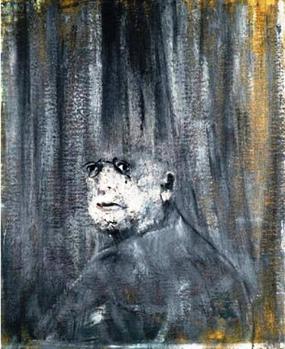Head III
Head III is a notable work in the realm of modern art, created by the influential British artist Francis Bacon. This painting is part of a series that delves into the complexities of human emotion, isolation, and existential angst, themes that are recurrent in Bacon's oeuvre. Head III, like its counterparts in the series, showcases Bacon's unique approach to portraiture, where the subject's identity is obscured, and the focus is shifted towards capturing the raw essence of human condition.
Background[edit | edit source]
Francis Bacon (1909–1992) was a pivotal figure in twentieth-century art, known for his emotionally charged and bold figurative paintings. Bacon's work often explores themes of death, fear, and the human psyche, employing a distinctive style characterized by its visceral, sometimes grotesque imagery and its use of distortion to convey emotion. Head III is a prime example of Bacon's fascination with the human head as a vessel of psychological depth and existential dread.
Description[edit | edit source]
Head III features an isolated figure set against a stark, nondescript background. The figure's head is depicted in a state of metamorphosis, with features that are simultaneously human and monstrous, blurring the line between identity and anonymity. Bacon's technique involves the use of rapid brushstrokes and a palette that is both vibrant and dark, creating a sense of turmoil and intensity. The figure appears trapped within a transparent cube, a motif that recurs in Bacon's work, symbolizing perhaps the confinement of the human condition or the isolation of the individual.
Themes and Interpretation[edit | edit source]
The themes of Head III are reflective of Bacon's broader artistic concerns. The painting can be interpreted as a meditation on the human experience, touching upon the feelings of alienation, confinement, and the search for meaning in an indifferent universe. Bacon's portrayal of the figure's distorted features challenges traditional notions of portraiture and identity, suggesting the fluid and often chaotic nature of the self.
Impact and Legacy[edit | edit source]
Head III is considered a significant piece within Francis Bacon's body of work, exemplifying his innovative approach to figuration and his contribution to the development of modern art. The painting has been the subject of extensive analysis and interpretation, contributing to the discourse on the role of art in expressing the complexities of human emotion and existence. Bacon's influence is evident in the work of subsequent generations of artists who have explored similar themes of the human condition through figurative art.
See Also[edit | edit source]
Search WikiMD
Ad.Tired of being Overweight? Try W8MD's physician weight loss program.
Semaglutide (Ozempic / Wegovy and Tirzepatide (Mounjaro / Zepbound) available.
Advertise on WikiMD
|
WikiMD's Wellness Encyclopedia |
| Let Food Be Thy Medicine Medicine Thy Food - Hippocrates |
Translate this page: - East Asian
中文,
日本,
한국어,
South Asian
हिन्दी,
தமிழ்,
తెలుగు,
Urdu,
ಕನ್ನಡ,
Southeast Asian
Indonesian,
Vietnamese,
Thai,
မြန်မာဘာသာ,
বাংলা
European
español,
Deutsch,
français,
Greek,
português do Brasil,
polski,
română,
русский,
Nederlands,
norsk,
svenska,
suomi,
Italian
Middle Eastern & African
عربى,
Turkish,
Persian,
Hebrew,
Afrikaans,
isiZulu,
Kiswahili,
Other
Bulgarian,
Hungarian,
Czech,
Swedish,
മലയാളം,
मराठी,
ਪੰਜਾਬੀ,
ગુજરાતી,
Portuguese,
Ukrainian
Medical Disclaimer: WikiMD is not a substitute for professional medical advice. The information on WikiMD is provided as an information resource only, may be incorrect, outdated or misleading, and is not to be used or relied on for any diagnostic or treatment purposes. Please consult your health care provider before making any healthcare decisions or for guidance about a specific medical condition. WikiMD expressly disclaims responsibility, and shall have no liability, for any damages, loss, injury, or liability whatsoever suffered as a result of your reliance on the information contained in this site. By visiting this site you agree to the foregoing terms and conditions, which may from time to time be changed or supplemented by WikiMD. If you do not agree to the foregoing terms and conditions, you should not enter or use this site. See full disclaimer.
Credits:Most images are courtesy of Wikimedia commons, and templates Wikipedia, licensed under CC BY SA or similar.
Contributors: Prab R. Tumpati, MD

